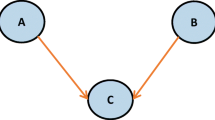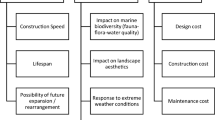Abstract
An oil spill is the accidental or intentional discharge of petroleum products into the environment due to human activities. Although oil spills are actually just a little percent of the total world oil pollution problem, they represent the most visible form of it. The impact on the ecosystems can be severe as well as the impact on economic activities. Oil spill cleanup is a very difficult and expensive activity, and many techniques are available for it. In previous works, a methodology based on different kinds of criteria in order to come to the most satisfactory technique was proposed and the relative importance of each impact criterion on the basis of the Saaty’s Analytic Hierarchy Process (AHP) was also evaluated. After a review of the best available techniques (BATs) available for oil spill response, this work suggests criteria for BATs’ selection when oil spills occur in the Mediterranean Sea under well-defined circumstances: calm sea and presence of economic activities in the affected area. A group of experts with different specializations evaluated the alternative BATs by means of AHP method taking into account their respective advantages and disadvantages.

Similar content being viewed by others
References
ARLEM (2013), Work programme, http://cor.europa.eu/en/activities/arlem/Documents/2013work-programme-en.pdf
Atlas RM, Hazen TC (2011) Oil biodegradation and bioremediation: a tale of the two worst spills in U.S. history. Environ Sci Technol 45:6709–6715
Bush S (2014) A new technology to cleaning oil spills with magnet, http://www.renewableenergyworld.com/rea/blog/post/print/2014/01/a-new-technology-to-cleaning-oil-spills-with-magnets\
Calcagnile P, Fragouli D, Bayer IS, Anyfantis GC, Martiradonna L, Cozzoli PD, Cingolani R, Athanassiou A (2012) Magnetically driven floating foams for the removal of oil contaminants from water. ACS Nano 26:5413–5419
Chen Y (ed) (2015) Nanotubes and nanosheets: functionalization and applications of boron nitride and other nanomaterials. CRC Press - Taylor & Francis Group, Boca Raton, USA
Cumo F, Gugliermetti F, Guidi G (2007) Best available techniques for oil spill containment and cleanup in the Mediterranean Sea. WIT Trans Ecol Environ 103:527–535. doi:10.2495/WRM070491
Das N, Chandran P (2011) Microbial degradation of petroleum hydrocarbon contaminants: an overview. Biotechnology Research International, Article ID 941810. doi: 10.4061/2011/941810
Dave D, Ghaly AE (2011) Remediation technologies for marine oil spills: a critical review and comparative analysis. Am J Environ Sci 7:423–440
Davidson WF, Lee K, Cogswell A (eds) (2008) Oil spill response: a global perspective. Springer, Dordrecht, The Netherlands
Etkin DS (2000) Worldwide analysis of marine oil spill cleanup cost factors. In: Proceedings of the 23rd Arctic and marine oil spill program technical seminar, Ottawa, Canada, 14–16 June, p. 161–174
Etkin DS (2001) Comparative methodologies for estimating on-water response costs for marine oil spills. In: Proceedings of the 2001 International Oil Spill Conference, Tampa, USA, 26–29 March, p. 1281–1289
Etkin DS (2004) Modeling oil spill response and damage costs. In: Proceedings of the 5th Biennial Freshwater Spills Symposium, St. Louis, USA, April 6–8
Etkin DS, Welch J (2005) Development of an oil spill response cost-effectiveness analytical tool. In: Proceedings of the 28th Arctic and Marine Oilspill Program Technical Seminar, Ottawa, Canada, 7–9 June, p. 889–922
Guidi G, Gugliermetti F, Violante AC (2009) Proposed criteria to select best available techniques (BATs) for oil spill response. Chem Eng Trans 17:367–372. doi:10.3303/CET0917062
Holakoo L, Mulligan CN (2002) On the capability of rhamnolipids for oil spill control of surface water. In: Proceedings of the Annual Conference of the Canadian Society for Civil Engineering, Montreal, Canada, 5–8 June
International Maritime Organization (2004) Bioremediation in marine oil spills. IMO, London, UK
International Tanker Owner Pollution Federation Limited (2011) Use of dispersants to treat oil spills. Technical Information Paper, http://www.itopf.com/tip4.pdf
Iqbal MZ, Abdala AA (2013) Oil spill cleanup using graphene. Environ Sci Pollut Res 20:3271–3279
Kharisov BI, Rasika Dias HV, Kharissova OV (2014) Nanotechnology-based remediation of petroleum impurities from water. J Petrol Sci Eng 122:705–718
Khushrushahi S, Zahn M, Hatton TA (2013) Magnetic separation method for oil spill cleanup. Magnetohydrodynamics 49:546–551
Macaulay BM, Rees D (2014) Bioremediation of oil spills: a review of challenges for research advancement. Ann Environ Sci 8:9–37
Mahajan YR (2011) Nanotechnology-based solutions for oil spills. Nanotechnol Insights 2(1):1–19
MARPOL (1973/1978) International Convention for the prevention of pollution from ships
McCall BD, Pennings SC (2012) Disturbance and recovery of salt marsh arthropod communities following BP deepwater horizon oil spill. PLoS One 7(3):e32735. doi:10.1371/journal.pone.0032735
MEMAC Fact Sheet, 2015, Application of dispersants in the ROPME sea area, circular, approved dispersant and application, Bahrain, www.memac-rsa.org
Nicolaides GK, Skountzos P, Atanassova Y, Koutroumbas K (1998) CLEANMAG®: the magnetic cleanup of waterborne oil spills—a new approach in the battle of oil spill cleanups. In: EUROMAT’98, Conference of the Portogues-European Material Society on Materials in Oceanic Environment, Lisbon, 22–24 July, vol. 1, p. 709–717
RAOP MED Project (2014) http://www.raop.eu/index.php/the-project/project-background
Saaty RW (1987) The analytic hierarchy process—what it is and how it is used. Math Mod 9:161–176
Saaty TL (1980) The analytic hierarchy process—planning. Priority Setting, Resource Allocation, McGraw-Hill Inc., New York
Saaty TL (2008) Decision making with the analytic hierarchy process. Int J Serv Sci 1:83–98
U.S. Environmental Protection Agency (1999) Understanding oil spills and oil spill response, http://www.hsdl.org/?view&did=25688
Zahed MA, Aziz HA, Isa MH, Mohajeri L, Mohajeri S (2010) Optimal conditions for bioremediation of oily seawater. Bioresource Technol 101:9455–9460
Zhu Q, Tao F, Pan Q (2010) Fast and selective removal of oils from water surface via highly hydrophobic core-shell Fe2O3@C nanoparticles under magnetic field. ACS Appl Mater Interfaces 2:3141–3146
Zhu X, Venosa AD, Suidan MT, Lee K (2001) Guidelines for the bioremediation of marine shorelines and freshwater wetlands. U.S. Environmental Protection Agency, Cincinnati, USA
Author information
Authors and Affiliations
Corresponding author
Additional information
Responsible editor: Philippe Garrigues
Rights and permissions
About this article
Cite this article
Guidi, G., Sliskovic, M., Violante, A.C. et al. Best available techniques (BATs) for oil spill response in the Mediterranean Sea: calm sea and presence of economic activities. Environ Sci Pollut Res 23, 1944–1953 (2016). https://doi.org/10.1007/s11356-015-5543-y
Received:
Accepted:
Published:
Issue Date:
DOI: https://doi.org/10.1007/s11356-015-5543-y




